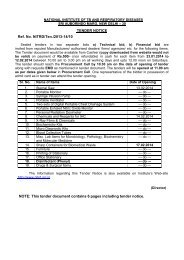The Indian Journal of Tuberculosis - LRS Institute of Tuberculosis ...
The Indian Journal of Tuberculosis - LRS Institute of Tuberculosis ...
The Indian Journal of Tuberculosis - LRS Institute of Tuberculosis ...
You also want an ePaper? Increase the reach of your titles
YUMPU automatically turns print PDFs into web optimized ePapers that Google loves.
HIV INFECTION AND PULMONARY TUBERCULOSIS 37<br />
Table 1. Report on T cell typing employing Dako*<br />
monoclonals and immunohistochemical<br />
technique (in cases 1 & 2)<br />
Cell Case 1<br />
type<br />
Case 2<br />
Laboratory<br />
controls<br />
Lymphocytes/cmm 6588 682 more than 1500<br />
CD4-T cells 1449 191 622-3510<br />
CD8-T cells 4282 109 277-1728<br />
CD4:CD8 Ratio 0.388 1.752 1.023-2.695<br />
Note 1: In case 1 there is no decrease in T4 cells, but<br />
CD4/CD8 ratio is decreased because <strong>of</strong><br />
increased cytotoxic T cells. 2: In case 2 there<br />
is decrease in T4 and T8 cells<br />
and the ratio CD4/CD8 is within normal<br />
limits.<br />
* Performed at the immunology laboratory <strong>of</strong><br />
Christian Medical College and Hospital, Vellore.<br />
Fig. 3. Skiagram <strong>of</strong> chest showing bilateral diffuse<br />
fibrocaseous infiltrations<br />
bilateral diffuse infiltrates (Fig. 3). Sputum smear<br />
was positive for AFB.<br />
As the patient had prior chemotherapy for<br />
about 2 years, with regimens containing<br />
Streptomycin, INH, Rifampicin and<br />
Pyrazinamide, he was put on Kanamycin,<br />
Ethionamide, Cycloserine, and INH (high dose).<br />
<strong>The</strong> sensitivity results obtained later showed<br />
strains resistant to Streptomycin, INH and<br />
Rifampicin. Patient developed an erythematous<br />
rash while on treatment which was treated first as<br />
non specific dermatitis but showed only partial<br />
clearing. After 6 weeks, the same rash was<br />
diagnosed as tinea infestation and treated with<br />
whitefield ointment with complete clearing. Antituberculosis<br />
treatment had been temporarily<br />
stopped after the appearance <strong>of</strong> rash. When it<br />
was restarted, one drug at a time, it was found<br />
that the patient did not tolerate Kanamycin,<br />
which was discontinued. <strong>The</strong> patient developed<br />
Herpes Zoster over the right back, localized to<br />
T8 and T9, later spreading to LI and L2 as well.<br />
This prompted us to look for HIV infection. With<br />
topical creams and steroids, it responded slowly<br />
to treatment. After four months <strong>of</strong><br />
chemotherapy, there was some radiological<br />
improvement but the sputum smear remained<br />
positive. He was discharged with advice to<br />
continue drugs on domiciliary basis. When the<br />
HIV result became available, the patient was<br />
readmitted on 9.1.1991. He was found smear<br />
positive even alter 6 months <strong>of</strong> chemotherapy,<br />
although he was clinically better,<br />
On readmission, he was put on Ethambutol,<br />
Ethionamide, INH, Oflaxacin and Trimethoprim<br />
Sulpha combination. <strong>The</strong> patient developed<br />
vomiting, <strong>of</strong>f and on, and drugs had to be stopped<br />
for brief periods. <strong>The</strong> patient had urticarial rash,<br />
due to intolerance to Trimethoprim-Sulpha<br />
combination and haemop-tysis for which styptics<br />
were given. He developed Tinea corporis again.<br />
This did not respond to Whitefield ointment for<br />
which reason Ketoconazole was given with<br />
remarkable improvement. On 5.5.1991, the<br />
patient complained <strong>of</strong> chest pain and<br />
breathlessness due to a left sided pneumothorax,<br />
which was managed by intercostal tube drainage.<br />
Later, the patient complained <strong>of</strong> throat pain and<br />
began bringing out cartilage like material in<br />
sputum. <strong>The</strong> E.N.T. specialist diagnosed it as<br />
pharyngitis sica. <strong>The</strong> patient had a bout <strong>of</strong><br />
haemoptysis on 17.5.1991, followed by sudden<br />
dyspnea and cardiorespiratory arrest. All<br />
measures <strong>of</strong> resuscitation failed and the patient<br />
expired.

















